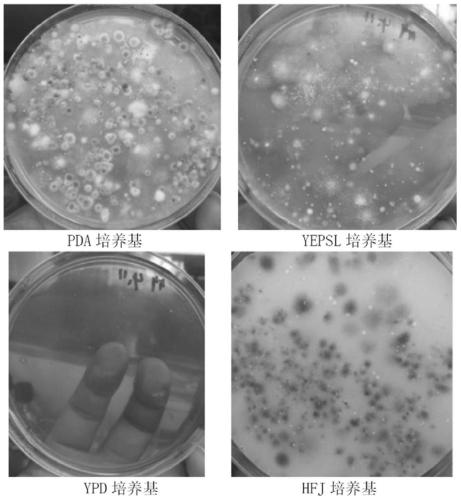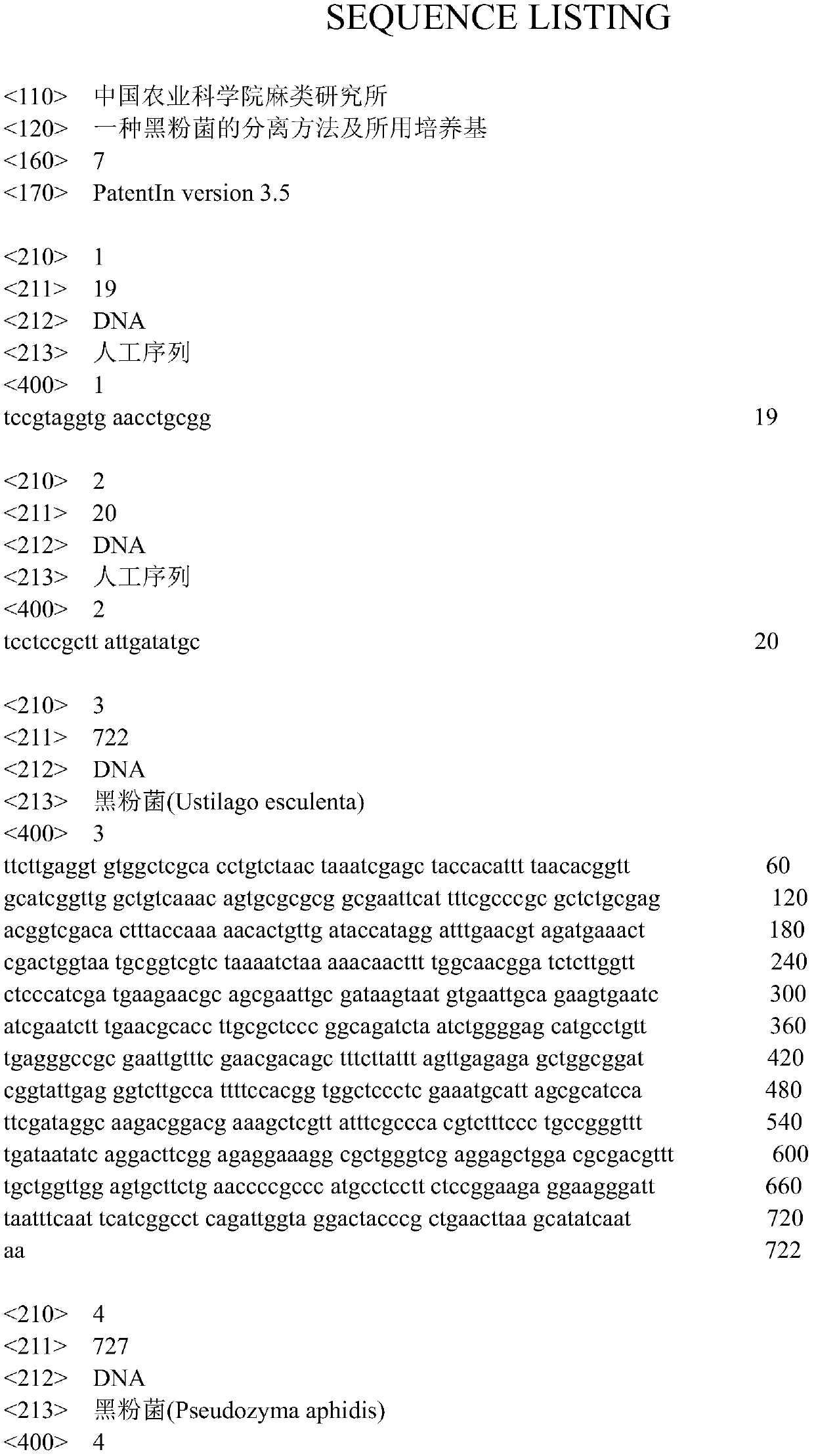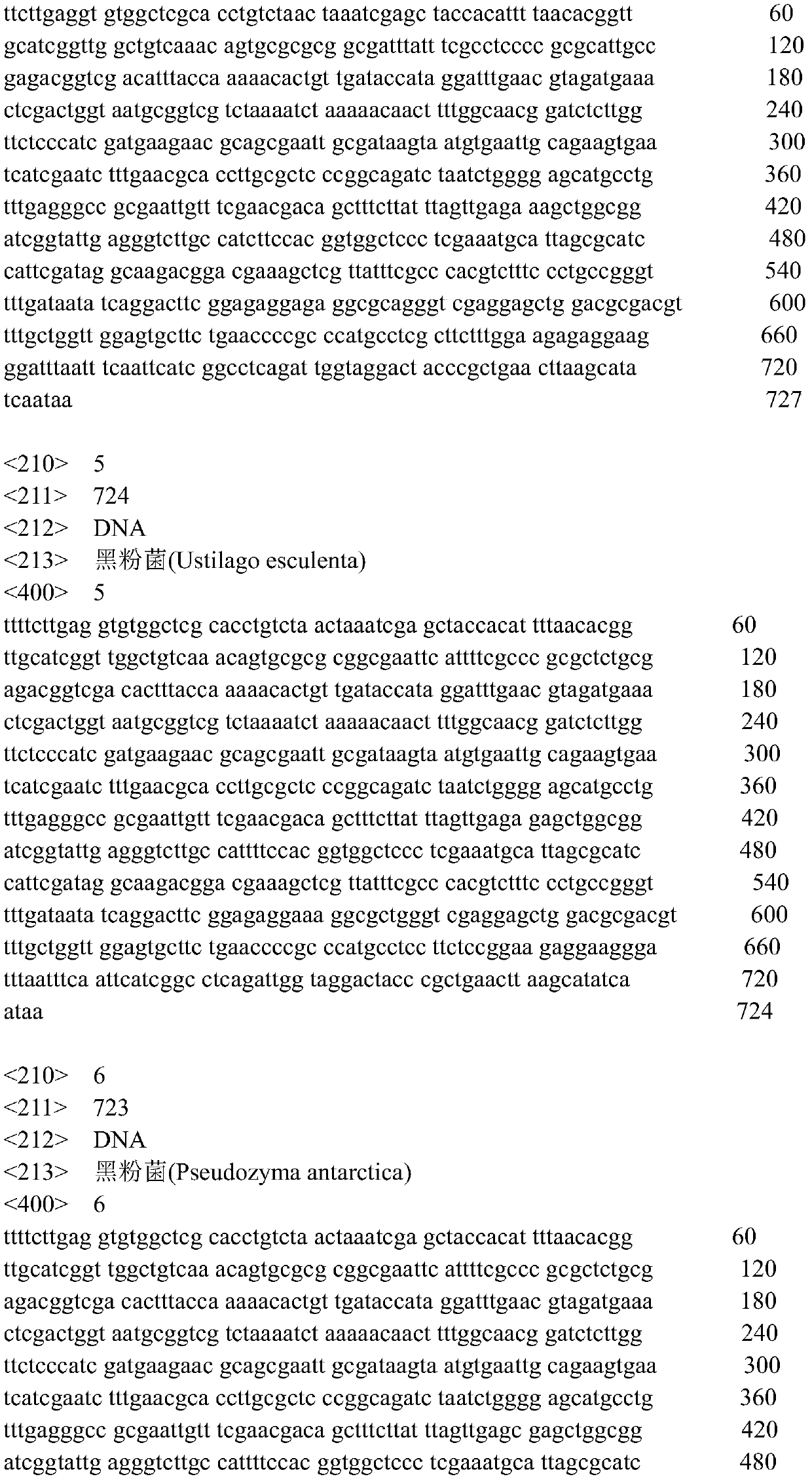A kind of separation method of smut and used culture medium
A separation method and technology of smut fungus, applied in the field of smut fungus separation method and the medium used, can solve the problems of inability to focus on the target smut fungus, low overall efficiency, and difficulty in obtaining, so as to improve the efficiency of separation and purification , improved efficiency, and simple sample handling
- Summary
- Abstract
- Description
- Claims
- Application Information
AI Technical Summary
Problems solved by technology
Method used
Image
Examples
Embodiment 1
[0058] This embodiment is to isolate smut fungus from Pteris cerevisiae without smut disease.
[0059] Prepare several kinds of solid media, namely ①PDA: 200g peeled potatoes boiled in water and finally filtered to obtain about 800ml of potato juice, add 20g glucose, 17g agar powder, natural pH value, add pure water to make up to 1L. ②YEPSL: Yeast extract 1%, peptone 0.4%, sucrose 0.4% and agar powder 1.7%, natural pH value; In addition, YEPSL liquid medium does not add agar powder. ③YPD: Yeast extract 1%, peptone 2%, glucose 2% and agar powder 1.7%. ④ HFJ separation medium: 0.4% sucrose, 0.5% calcium carbonate, 0.02% magnesium sulfate, 0.02% potassium dihydrogen phosphate, 1.5% agar powder, adjust the pH value to 6.8.
[0060] The above-mentioned several mediums were bottled and sealed, and sterilized under high temperature and high pressure at 115°C and 0.20Mpa for 18 minutes. Streptomycin and cephalosporin were added to the culture medium with agar powder cooled to 60-65°...
Embodiment 2
[0070] This embodiment is to isolate smut fungus from Zizania zizania with smut disease (Zizania stem enlargement is the result of Zizania smut Ustilago esculenta infection).
[0071] The difference between this example and Example 1 is that only the solid and liquid medium of HFJ solid medium and YEPLS are prepared. The effects of these two media on the separation of stem-expanded Zizania stems were compared. Among them, the proportion of solid HFJ separation medium is slightly different from that of Example 1: 1% glucose, 0.2% calcium carbonate, 0.05% magnesium sulfate, 0.03% potassium dihydrogen phosphate, 2% agar powder, pH 6.5.
[0072] 15 colonies were picked from each culture medium for identification, and the results: the yeast colonies isolated from the YEPSL medium were all yeasts; while the smut was isolated from the HFJ medium, respectively. are Ustilagoesculenta and Pseudozyma aphidis.
[0073] The ITS sequence sequencing results of two smut fungi are:
[0074]...
Embodiment 3
[0080] This embodiment is to isolate smut from storage rice without smut disease.
[0081] The difference between this example and Example 2 is that only HFJ solid medium and YEPLS liquid medium are prepared. Among them, the proportion of the solid HFJ separation medium is slightly different from that of Example 2: 1% mannitol, 0.4% calcium carbonate, 0.04% magnesium sulfate, 0.05% potassium dihydrogen phosphate, 2% agar powder, and the pH value is 7.0.
[0082] The stored rice without smut disease was ground and then isolated and cultivated.
[0083] Finally, 10 non-reflective white colonies were picked for culture and identification. ITS sequence alignment results: 8 colonies were Ustilago esculenta (100% similarity in NCBI); the other 2 colonies were similar to Pseudozymaantarctica in NCBI Yes 100%.
[0084] >ITS Ustilago esculenta (rice)
[0085] TTTTCTTGAGGTGTGGCTCGCACCTGTCTAACTAAATCGAGCTACCACATTTTAACACGGTTGCATCGGTTGGCTGTCAAACAGTGCGCGCGGCGAATTCATTTTCGCCCGCGCTCTGCGAGACG...
PUM
 Login to View More
Login to View More Abstract
Description
Claims
Application Information
 Login to View More
Login to View More - R&D
- Intellectual Property
- Life Sciences
- Materials
- Tech Scout
- Unparalleled Data Quality
- Higher Quality Content
- 60% Fewer Hallucinations
Browse by: Latest US Patents, China's latest patents, Technical Efficacy Thesaurus, Application Domain, Technology Topic, Popular Technical Reports.
© 2025 PatSnap. All rights reserved.Legal|Privacy policy|Modern Slavery Act Transparency Statement|Sitemap|About US| Contact US: help@patsnap.com



